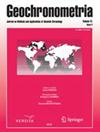年代研究中铅210的β(LSC)和γ(HPGe)光谱测定方法的比较
IF 0.9
4区 地球科学
Q3 Earth and Planetary Sciences
引用次数: 4
摘要
摘要对位于东欧平原西部波罗的海高地(立陶宛东部和波兰东北部)的两个湖泊的沉积物进行了研究。使用两种核分析技术测定210Pb的活性浓度:使用液体闪烁计数器(LSC)测定与其β-发射子体210Bi平衡的210Pb,以及使用井型HPGe探测器的低背景伽马射线光谱仪直接测定210Pb(和其他放射性核素)。对于LSC测定210Pb,使用了基于Cl–形式阴离子交换树脂(Eichrom)的铅分离方法。另外还研究了放射化学程序的几个步骤和各自的参数。使用LSC方法的优化程序对两个湖芯进行了案例研究。对基于LSC和HPGe两种核分析技术的湖泊沉积物样品中210Pb的活性浓度进行了比较。根据210 Pb恒定供应速率(CRS)模型对岩心进行了210 Pb定年,并进行了一些修改。在不确定性范围内,这两种技术都给出了类似的结果。从两个考虑的湖泊来看,富营养化程度较高的湖泊表现出较高的沉积物质量累积率(MAR)值。本文章由计算机程序翻译,如有差异,请以英文原文为准。
Comparison of beta (LSC) and gamma (HPGe) spectrometric methods for lead-210 in chronological study
Abstract The sediments of two lakes located in the Baltic Uplands, the western part of the East European Plain (East Lithuania and North East Poland), were studied. Activity concentration of 210Pb was determined using two nuclear analytical techniques: determination of 210Pb in equilibrium with its beta emitting daughter 210Bi using liquid scintillation counter (LSC), and direct determination of 210Pb (and other radionuclides) by low-background gamma-ray spectrometer with a well type HPGe detector. For the 210Pb determination by LSC the methodology of lead separation based on the anion exchange resin in Cl– form (Eichrom) was used. Several steps of radiochemical procedures and respective parameters were investigated additionally. The optimized procedures for LSC method were used for case study with two lake cores. The activity concentration of 210Pb in lake sediment samples based on both nuclear analytical techniques (LSC and HPGe) were compared. 210Pb dating of cores was performed according to Constant Rate of 210Pb Supply (CRS) model with some modifications. Both techniques in the range of uncertainties gave similar results. From two considered lakes, the more eutrophic one exhibited higher sediment mass accumulation rate (MAR) values.
求助全文
通过发布文献求助,成功后即可免费获取论文全文。
去求助
来源期刊

Geochronometria
地学-地球科学综合
CiteScore
2.20
自引率
0.00%
发文量
1
审稿时长
>12 weeks
期刊介绍:
Geochronometria is aimed at integrating scientists developing different methods of absolute chronology and using them in different fields of earth and other natural sciences and archaeology. The methods in use are e.g. radiocarbon, stable isotopes, isotopes of natural decay series, optically stimulated luminescence, thermoluminescence, EPR/ESR, dendrochronology, varve chronology. The journal publishes papers that are devoted to developing the dating methods as well as studies concentrating on their applications in geology, palaeoclimatology, palaeobiology, palaeohydrology, geocgraphy and archaeology etc.
 求助内容:
求助内容: 应助结果提醒方式:
应助结果提醒方式:


